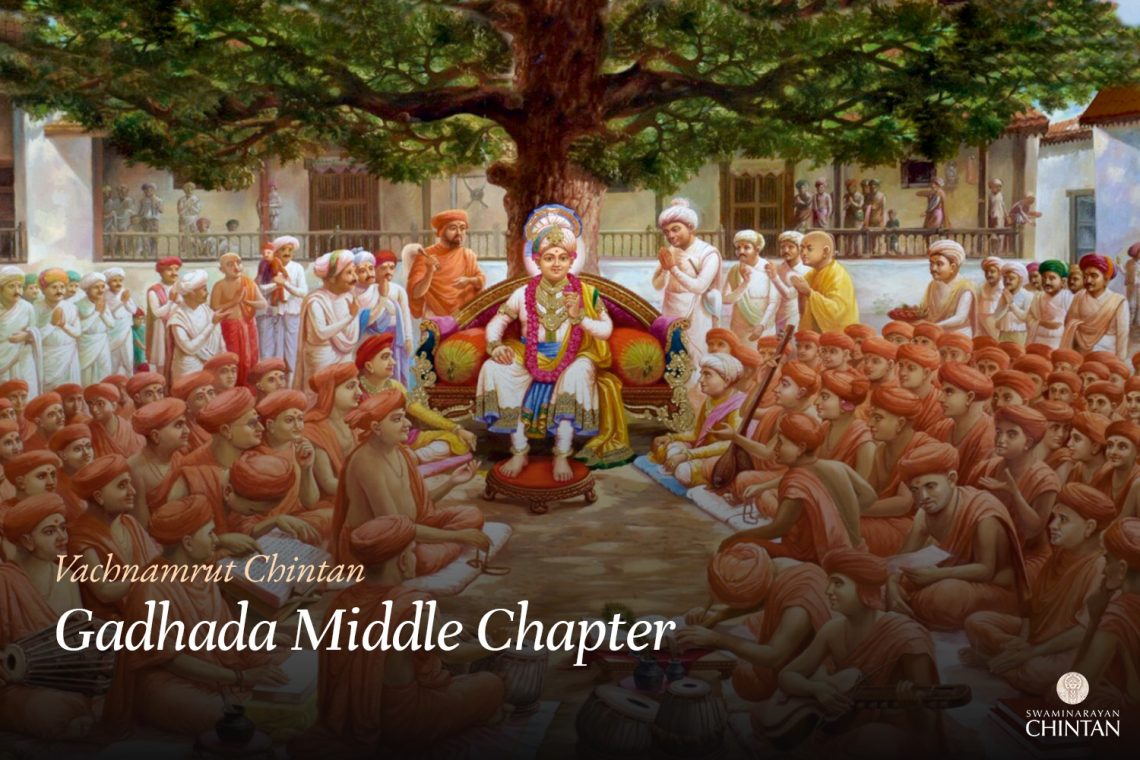Central Insights:
- The steadfastness of Yog and the steadfastness of Sankhya.
Key Points:
- Concentrating the mind through practice and rising above pleasure and pain is the perspective of Yog.
- Learning to see the dreadful miseries hidden behind seemingly delightful pleasures is the perspective of Sankhya.
Explanation:
In this Vachanamrut, Muktanand Swami asks a question: “Is there any distraction that can hinder a devotee who has unwavering faith in Bhagwan?” In response, Maharaj explains that there are two types of steadfastness: Yog-oriented steadfastness and Sankhya-oriented steadfastness.
Yog-oriented steadfastness is the determination that is strengthened by the practice of Yog. On the other hand, Sankhya steadfastness is the determination strengthened by intellectual discernment (Sankhya).
A devotee who follows Yog keeps his focus on the divine image of God through the strength of practice. While his understanding may not be as strong, his skill in practice is more developed.
In contrast, a devotee following Sankhya has greater intellectual strength. He measures and evaluates both the joys and sorrows of human life and decides what to accept or reject based on his understanding. He also evaluates the pleasures of the Siddha, Charan, Gandharva, deities, and other beings in the fourteen realms. He calculates not only the joys found in these realms but also the possible sufferings that could follow. By considering both happiness and distress—keeping in mind both perspectives, from earth to Akshardham—he remains undisturbed by circumstances of time and place. A Yogi, however, relies on the strength of practice, and while his mind may remain focused on Bhagwan, adverse circumstances can lead his mind to be distracted elsewhere, creating obstacles.
Thus, when one combines the two, Yog and Sankhya, there is no possibility of any shortcomings.
What is Sankhya? It is the ability to measure the suffering hidden behind pleasures. This is called the Sankhya perspective. If someone can measure the immense misery lurking behind delightful pleasures, then that person has developed a Sankhya perspective. Only measuring the positive aspects of pleasure is known as the Yog perspective. The joy of meditation and devotion is a Yog perspective, whereas understanding the hardship behind any happiness is a Sankhya perspective.
Glossary
| Sankhya – A school of philosophy A philosophical system that explains the nature of the soul and the universe, emphasizing the distinction between the soul (Atma) and the material world. |
| Yog – Union or spiritual practice A philosophical and practical discipline aimed at achieving union with the divine through meditation, control of senses, and spiritual focus. |
| Steadfastness – Firm determination Unwavering focus and strength in spiritual practice or intellectual understanding. |
| Siddha – Souls who have attained supernatural abilities but remain in the cycle of creation. |
| Charan – Celestial beings A type of divine being, known for their devotion and service to Bhagwan. |
| Gandharva – Divine musicians Celestial beings associated with music, often serving in the divine realms. |
| Fourteen Realms – Levels of existence in universe The various planes of existence in creation, including heavenly and earthly realms. |
| Akshardham – The eternal supreme abode of Bhagwan Swaminarayan The divine abode where Bhagwan Swaminarayan resides along with Akshar Muktas (Divine Liberated Souls) |
| Yog Perspective – Focus on joy in devotion The view that emphasizes the bliss and benefits of spiritual practice and meditation. |
| Sankhya Perspective – Understanding hidden miseries The approach that discerns the suffering concealed within worldly and sensory pleasures. |

